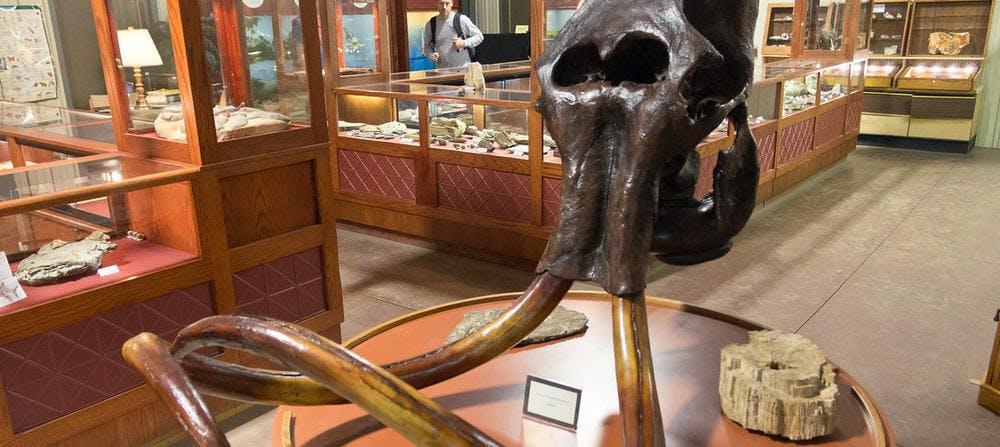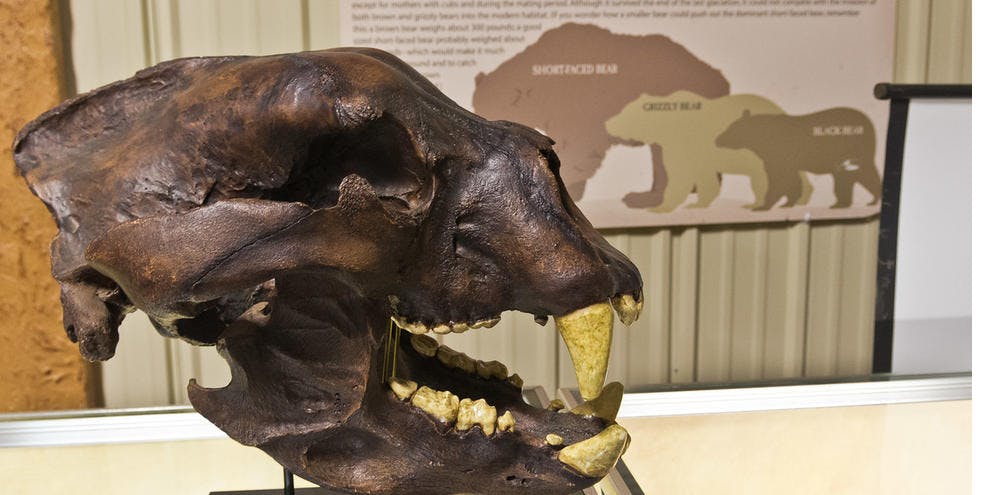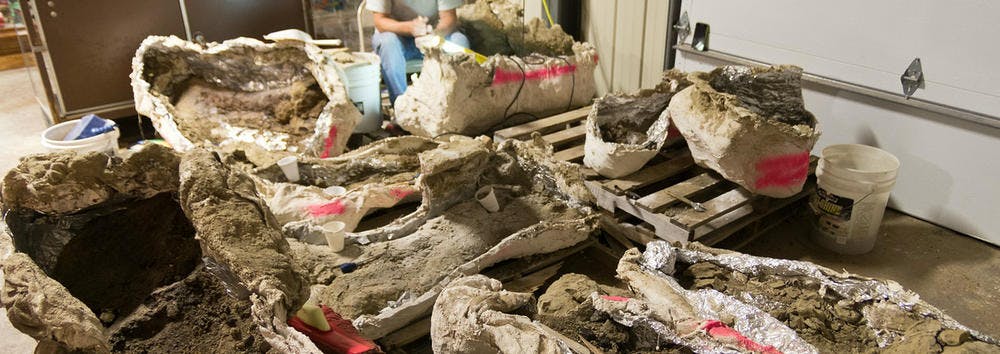Did you know that you can tell the difference between a fossilized bone and a rock by pressing it to the inside of your bottom lip and seeing if it sticks? If it does, it’s bone. This is called the “spit test” and is just one of the fascinating things I learned from director Matt Forir at the Missouri Institute of Natural Science’s Riverbluff Cave Museum.

Missouri Institute of Natural Science's Riverbluff Cave Museaum in home to hundreds of fossils, both local and from other parts of the world.
Walking up to the warehouse that contains the museum, I never would have guessed the multitude of interesting things inside. When I first walked in the door, I noticed a small gift shop area with fossils and multicolored minerals, but what really caught my attention was the size of the room and how many display cabinets there were. The large room is divided in half - one side for artifacts to do with Riverbluff Cave and the other half for artifacts from the present to thousands of years ago.
I wandered over to the Riverbluff side right about the time Mr. Forir started to give a presentation to a group of seniors. This side of the room has three long display cabinets along the perimeters of the space filled with all sorts of remarkable fossils and artifacts: mammoth bones and teeth, different animal skulls, fossilized dung and footprints. There was also a large clay reproduction of the ancient bear scratches that extended from floor to ceiling. Listening to Mr. Forir’s presentation, I noticed right away how friendly and engaging he is. He constantly made jokes, and nothing he said sounded like a boring professor. Many times he asked the audiences’ opinions and made examples from them. And his smile was contagious.
Riverbluff Cave cave was discovered on September 11, 2001 when construction crews were blasting away at rock for a new road. The group of people who investigated the gaping hole in the earth left by the explosion were the first people to ever step foot in this cave. It is the oldest fossil cave site in
North America with the least amount of human impact. The layers of sediment in the cave have been dated from 600,000 years old all the way back to 1,000,000 years old. There are fossils and other evidence of the animals that made this cave their home hundreds of thousands of years ago.

The Giant Short Faced Bear is said to have stood taller than a grizzley bear, run up to 40mph and at one point inhabited Riverbluff Cave.
The Giant Short-Faced Bear has many sleeping indents dug into the caves floor as well as giant scratch marks extending upwards of 15 feet! Hundreds of peccary footprints were found fossilized in the cave proving that these animals were not just dragged into the caves as meals but lived there as well. There is evidence of ancient wolves and cats, and some camel bones were found as well. Apparently camels were indigenous to North America. Who would have known?!
After the presentation, I found time to explore the rest of the museum before talking to Mr. Forir. It took me three trips to see everything because I kept getting distracted by something new and exciting I hadn’t noticed before. Along two sides of the second half of the museum are large collections of minerals. There is every mineral I can remember ever learning about in class and they are all so beautiful! I especially enjoyed the small, covered mineral display case that had UV lights to show the different properties of the minerals; they all glowed as if they had just got back from a glow paint party! The furthest wall of this half had several dioramas showing different soil layers and the fossils found in each as well as the ancient sea creature that once called the Midwest home. Yeah, apparently our town and region was once at the bottom of a very large sea! But it was the fossils that really captivated me. There are fossils of hundreds of different organic compounds. Dino bones, ancient fish and bugs were preserved in rock. Most interesting to me were the fossilized pine cones and plants because I didn’t know those could become fossilized.

Henry the Triceratops, a hands on addition to the museum. Some assembly required.
The absolute coolest part of this museum is tucked away in a corner behind some display cabinets and the gift shop. Henry the Triceratops sits in pieces in this corner waiting to be put back together. How many times have you seen dino bones or a full skeleton on display behinds some bars and glass at a museum? A lot, I’m sure. Well here, they really inspire creativity and imagination because they have Henry’s bones in casts waiting to be cleaned up and put back together right on the floor, no bars or glass in the way. And it gets better. You can actually touch the bones and hold them, with supervision, of course. Mr. Forir has even been known to allow children to help him clean up the bones and put the pieces together! Getting to hold one of Henry’s bones turned this 21 year old into a 6 year old in less than 5 minutes! I do believe I bragged to all of my friends about it.
After my little adventure around the museum, I was able to have a one-on-one talk with Mr. Forir. He explained how the non-profit museum is like a child to him. He has overseen the project since the beginning and has big visions for its future. A bigger building, larger classroom and more dinosaurs are just a few of Mr. Forir’s dreams. His main goal is that this museum inspires and includes everyone. The education of younger generations are what drives his vision. He believes science should “be accessible and fun”.
Riverbluff Cave Museum and Mr. Forir have quite an interesting view on science and history and it is evident the minute you walk through the large warehouse doors. I had an amazing time getting to learn about Missouri’s past and the ancient giants that once walked these lands. I encourage anyone, from couples looking for a quirky date to children on a school fieldtrip to individuals curious about archeology and our past to check out this stop on the map.














